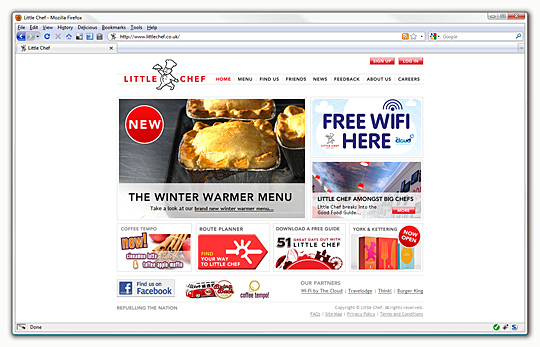
The longest running and most high-profile website I have the pleasure of working on is for Little Chef. With such a recognisable brand and in a period of increased company activity, the site is increasing its role as the primary communication with customers. With a recent aesthetic refresh which only select parts of the site were quick to follow, the remainder was still stoically in the old style - updating the rest was a deceptively large task and exposed the opportunity to rectify some of the niggling obstructions that had grown with the site. What on the surface was just a visual update was in a fact a more far-reaching upgrade.
if these were the most complicated aspects of the site the rebuild would have been simpler and drastically more straightforward.
Rebuilding an existing site always starts with the best intentions - glassy eyed optimism seeing only improvements and never pitfalls, but experience has taught temperance rather than ambitious extravagance. Ambivalence is quick to set in: on the one hand there is a full and detailed specification available in the form of the currently used site, while on the other it soon becomes rapidly apparent that with history comes refinement that may not lend itself to rapid reconstruction. Striking a balance between reconstructing for improvement and the silent threat of feature creep is the key to a timely and successful project.
Read the rest of this entry

The whole orange by Tim Dorr used under Creative Commons Attribution-Non-Commercial-Share Alike license
The first part of this series was a heavy on lists and common sense and light on the details. Cacti tend to be more interesting than audits, despite their importance, and the amount of work being put into such a security hazard can seem ill spent when all you want to do is get down and start fiddling. This is what the plan is all about. It marries riotous list-making with tinkering joy.
what may seem expensive now may be cheap in comparison to possible hair-pulling later
Toys!
The first thing I did when the prospect of a new server arose, before looking at prices or stats, was make a wishlist of everything that I wanted. Despite working without incident for so long, there are places and processes where certain aspects could be smoother – this is the case with any computer and having the time to figure out improvements is a rare joy; opposed something breaking and a near-as-dammit replacement is swiftly procured.
The wishlist was split into areas which are a pain to currently work with and areas where it would be good to try something different. The latter is obviously the more contentious – why change if it works – however I always like to try something new for every project, how else can I learn?
Read the rest of this entry

Windows Servers - Data Center by jaxmac used under Creative Comments Attribution-Non-Commercial-No Derivative Works license
For a small digital agency, running an off-site server is as important as it is unglamorous. You don’t get any of the desirable super-tech of running a cluster but all of the headaches of running a constantly used, high-availability external computer. My workplace’s existing dedicated server (which I championed, configured and maintain) is used to provide web hosting to a variety of clients – both large and small – and for the past three and half years has provided a flawless service. Upgrading is not to be taken lightly and the reasons for doing so must always result in a better service to clients – whether that’s decreased work load for you or improved site responsiveness. For me it boiled down to entropy: three and a half years is a long time for hardware to run and it will eventually fail and make my day/week/month hell on toast.
First step on this crazy adventure: audit.
Cleaning house
the more you know and the better prepared you are, the easier it’s going to be
Audit is a filthy word round most parts and conjures up images of bespectacled pencil-pushers or greasy tax collectors. Despite this, documenting what you have is the first step to getting something better. When I begun this process however I found that, like a house, over time a server accumulates clutter: old domains, long since defunct sites, errant processes; automation only goes so far before a cleaner has to step in.
Spending a day archiving and removing cruft is tantamount to dusting the shelves and throwing away old books and furniture before moving house – it reduces the effort required later in the process. My removals included:
- Domain name end-points – for ones which had either expired or the persons / companies had moved on
- E-mail accounts – accounts for expired domains are useless, just as accounts for long since lapsed campaigns are
- Test folders – a separate test environment means accumulation of in-progress sites was inevitable. I found a year without modification is a good metric for when to cull
- Errant services – automated / scheduled processes such as a log-parsers; awstats was set to run on Apache’s log files – no longer necessary when every site we host uses Google Analytics
- Old databases – very few of these but the odd one sometimes slips through
After archiving, it was time for the document itself.
Read the rest of this entry


